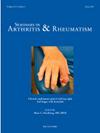我们能在非风湿病专家的年轻人中识别轴型脊柱炎吗?夏尔巴人研究的结果
IF 4.4
2区 医学
Q1 RHEUMATOLOGY
引用次数: 0
摘要
目的确定在风湿病专家以外的专家诊断的年轻成人慢性背痛(CBP)的患病率和与axSpA诊断相关的特征,并评估该人群中骶髂关节(SIJ)的磁共振成像(MRI)。方法于2021年7月至2023年10月进行前瞻性观察性研究。年龄在18-40岁的CBP患者被非风湿病专家推荐进行脊柱MRI检查。参与者完成了一份评估背痛特征和SpA特征的自我管理问卷。脊柱MRI扩展至SIJ。之后,由风湿病学家对参与者进行评估,根据临床评估和补充测试确定axSpA的诊断。结果入选的268例患者中,确诊axSpA 8例(3.0%),疑似axSpA 14例(5.2%),确诊或疑似axSpA的患者占8.2%。臀部疼痛(54.5% vs. 24.3%;p = 0.04),非甾体抗炎药改善(68.2% vs 36.5%;P = 0.02),症状持续时间较短(3.5年vs. 5.1年;p = 0.02), HLA-B27阳性(27.3% vs. 3.3%;p & lt;0.01), CRP水平升高(36.4% vs. 12.2%;p = 0.01)与axSpA诊断相关。MRI结果显示,大多数患者出现脊柱退行性病变,近三分之一的患者出现SIJ异常,在axSpA患者中更为常见。在我们的CBP青年队列中,大约8%的人被诊断为明确或疑似axSpA。大多数患者报告了MRI脊柱病变,而三分之一的患者报告了SIJ发现。本文章由计算机程序翻译,如有差异,请以英文原文为准。
Can we identify axial spondyloarthritis among young adults referred to non-rheumatology specialists? Results from the SHERPAS study
Objective
To determine the prevalence and features associated with axSpA diagnosis in young adults with chronic back pain (CBP) referred to specialists other than rheumatologists, and to evaluate magnetic resonance imaging (MRI) of sacroiliac joints (SIJ) in this population.
Methods
A prospective, observational study was conducted from July 2021 to October 2023. Adults aged 18–40 years with CBP referred for spinal MRI by non-rheumatology specialists were included. Participants completed a self-administered questionnaire assessing back pain characteristics and SpA features. The spinal MRI was extended to SIJ. Thereafter, participants were evaluated by a rheumatologist, who established the diagnosis of axSpA based on clinical evaluation and complementary tests.
Results
Among 268 patients enrolled, 8 (3.0 %) were diagnosed with definite axSpA, and 14 (5.2 %) suspected axSpA cases, resulting in a total of 8.2 % with definite or suspected axSpA. Buttock pain (54.5 % vs. 24.3 %; p = 0.04), improvement with NSAIDs (68.2 % vs. 36.5 %; p = 0.02), shorter symptom duration (3.5 vs. 5.1 years; p = 0.02), HLA-B27 positivity (27.3 % vs. 3.3 %; p < 0.01), and elevated CRP levels (36.4 % vs. 12.2 %; p = 0.01) were associated with axSpA diagnosis. MRI findings revealed spinal degenerative lesions in most patients, and SIJ abnormalities in almost one third, being more common in patients with axSpA.
Conclusion
In our cohort of young adults with CBP referred to non-rheumatology specialists, approximately 8 % were diagnosed with definite or suspected axSpA. MRI spinal lesions were reported in most patients, while SIJ findings were reported in one out of three patients.
求助全文
通过发布文献求助,成功后即可免费获取论文全文。
去求助
来源期刊
CiteScore
9.20
自引率
4.00%
发文量
176
审稿时长
46 days
期刊介绍:
Seminars in Arthritis and Rheumatism provides access to the highest-quality clinical, therapeutic and translational research about arthritis, rheumatology and musculoskeletal disorders that affect the joints and connective tissue. Each bimonthly issue includes articles giving you the latest diagnostic criteria, consensus statements, systematic reviews and meta-analyses as well as clinical and translational research studies. Read this journal for the latest groundbreaking research and to gain insights from scientists and clinicians on the management and treatment of musculoskeletal and autoimmune rheumatologic diseases. The journal is of interest to rheumatologists, orthopedic surgeons, internal medicine physicians, immunologists and specialists in bone and mineral metabolism.

 求助内容:
求助内容: 应助结果提醒方式:
应助结果提醒方式:


